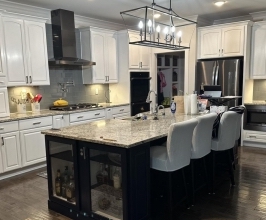Interview by Christine Adams with Ryan Denny:
Ryan, what is the first thing comes to mind when formulating a new finish?
The first thing is always the objective or the result you want to achieve. I look first at the chemistry backbone, what type of resin needs to be used, either polyurethane, acrylic, or water alkyd. The resin is going to dictate the performance or durability of the finish.
Give us an example of the decisions that affect an exterior finish.
With an exterior finish, you must keep two things in mind. 1) People forget that wood is always going to degrade no matter what finish you put on it. 2) You must approach wood finishes as a maintenance product. Wood finishes are outside in severe changes of temperature, sunlight, and moisture. At the end of the day, Mother Nature will always win over one application. Neither the conditions nor the substrate can be controlled.
To learn how to maintain your exterior finishes, visit the product pages at www.generalfinishes.com.
Ryan, when you are selecting resins for an exterior finish, what attributes are important?
When selecting resins, I look for a balance of three qualities: a balance of durability and hardness, elongation, and UV resistance.
Hardness does not equate to durability, and it must be balanced. Think of the difference between glass vs plexiglass. Glass is hard, but if you throw a rock at it, it will crack and break. If you throw a rock at plexiglass, it will bounce off. You don’t want too hard of a finish out in the weather – a hard finish cannot handle sun and heat.
Elongation means the finish will flex with the temperatures and not delaminate or crack.
UV resistance is achieved with resin selection and additives. UV stabilizers are used to retard the degradation of the coating. And here is a MYTH BUSTER: a finish will NOT stabilize the color shift or integrity of the wood, just the integrity of the finish.
Finally, remember that exterior finishes are “water-resistant” and not “water-impervious.” Exterior finishes such as stains and clears perform longer on vertical surfaces such as garage doors, windows, exterior doors, and furniture. Large horizontal surfaces, such as decks, fare better with pigment-based coatings because of the heavy beating they take from the sun. To learn how to maintain your exterior finishes, visit the product pages at www.generalfinishes.com.
New technologies are advancing in the exterior-finish arena, but continue to use these finishes wisely as a maintenance product, with respect for Mother Nature and the many variances in the substrate.

 Enduro Water-Based Conversion Varnish
Enduro Water-Based Conversion Varnish
 Enduro Water Based Stain Blocker Primer
Enduro Water Based Stain Blocker Primer
 Enduro Water-Based Tintable 2K White Poly
Enduro Water-Based Tintable 2K White Poly
 Enduro Water-Based Pro Series White Polyurethane
Enduro Water-Based Pro Series White Polyurethane
 Hard Wax Oil & Hardener
Hard Wax Oil & Hardener
 Gel Stains
Gel Stains
 Pro Image Flooring Topcoat
Pro Image Flooring Topcoat
 Jen Poly Brushes
Jen Poly Brushes
 Stir Stix
Stir Stix
 Ultraflex Softback Sanding Sponge
Ultraflex Softback Sanding Sponge










